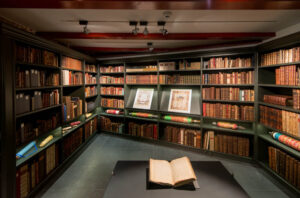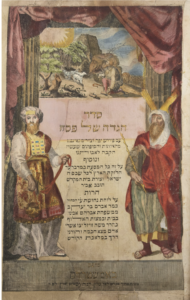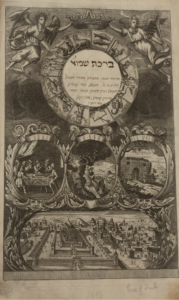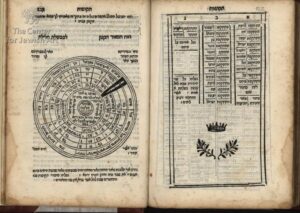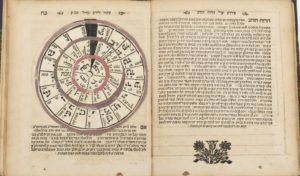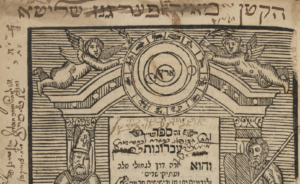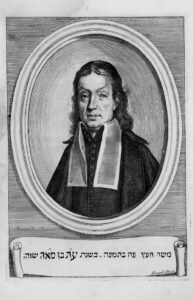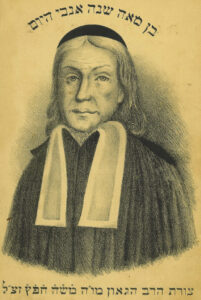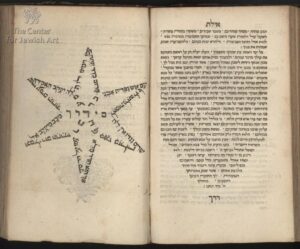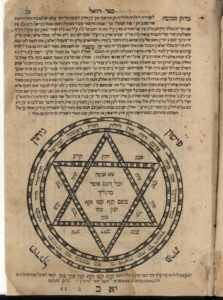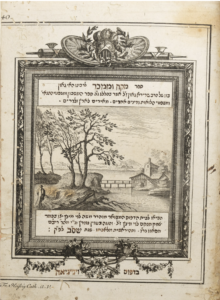An Obscure Chumash Changes the Sefer HaChinuch Forever
An Obscure Chumash Changes the Sefer HaChinuch Forever[1]
By Eli Genauer
I have a sefer in my collection with a very busy Shaar Blatt:
It is a Chumash printed by Yosef, Yaakov, and Avraham Proops in Amsterdam, 1767.[2] The Chumash contains some of the normal additions, such as Targum Onkelos and Rashi, along with two additions which are indicated as being “ואלה מוסיף על הראשונים”. I would like to focus on one of these additions, the Sefer HaChinuch. Placing the words of the Sefer HaChinuch underneath the text of the Chumash certainly made sense in theory, as one could review its words as one studied the Parsha. But it caused two major problems, one of which could be solved by use of a magnifying glass, and the other which brought about a change in the Sefer HaChinuch “עד היום הזה”.
The Sefer HaChinuch describes the details of, and reasons behind, the 613 Mitzvot.[3] Some of the explanations are very short, such as מצות אכילת מצה, (Mitzvah 10 -Shemot 12:18) so they fit nicely underneath a Pasuk. But when one Pasuk contains 3 Mitzvot and the lengthy explanations need to be placed underneath it (along with Onkelos, Rashi and Peirush Devek Tov), it creates a big problem with space. The only solution would be to have just one Pasuk on a page and to use smaller typeface for the Sefer HaChinuch than for Rashi. Here is how one page looks (Shemot 23:2). It includes Mitzvot 76,77 and 78.
This idea of including the Sefer HaChinuch in a “regular” Chumash was tried once again in 1783 in Frankfurt an der Oder, but perhaps because of this issue of space, never again after that.
This edition of the Chumash, which revised the order of the listing of the mitzvot, also altered the sequence in subsequent editions of the Sefer HaChinuch. This is despite the fact that the author of the Sefer HaChinuch specifically lists the Mitzvot of each parsha in one format. The Proops brothers’ edition of the Chumash overrode the author’s approach.[4] The original order for each Parsha is to list the מצוות עשה first and the מצוות לא תעשה afterwards. Here is how the Mitzvot of Parshat Tetzaveh are ordered in the oldest manuscript copy of the Sefer HaChinuch:
https://digi.vatlib.it/view/MSS_Vat.ebr.163[4]
This order was preserved in subsequent manuscripts, and in the first printed edition of Sefer HaChinuch.[6]
In placing the מצוות עשה first and then the מצוות לא עשה, the author of the Sefer HaChinuch is following the model of the Sefer HaMitzvot of the Rambam.[7] As he writes in Mitzvah 138:
עִם כָּל זֶה מִדֶּרֶךְ חֶשְׁבּוֹן הָרַמְבַּ“ם זִכְרוֹנוֹ לִבְרָכָה אֲשֶׁר [נִתְפַּשֵּׁט] בַּמִּצְוֹת לֹא נִטֶּה…. כִּי הוּא בֶּאֱמֶת סִבָּתֵנוּ בְּעֵסֶק זֶה, וּמִיָּדוֹ זָכִינוּ לוֹ….
This division is also preserved in the headings of the halakhot in Mishneh Torah, and Sefer HaChinuch then follows it.
But this order would not work for a Chumash designed to have the Mitzvot aligned with the Pesukim in the order they appeared in the Parsha, because the מצוות עשה and מצוות לא תעשה are interspersed within the Parsha. For example, Mitzvot 98 and 99 are מצוות עשה and come first in the Parsha. But Mitzvah 102 (a מצות לא תעשה) follows Mitzva 99(a מצות תעשה) in the Parsha so it becomes Mitzvah 100. Here is how it looks in a modern volume:
This change in the numeration of the Mitzvot was not lost on the Proops brothers, and they note that they hoped Torah scholars would look favorably on this change.
“And now, this treasured Sefer ( HaChinuch) has been modernized according to the order ( of the Pesukim of the Chumash) so that the reader can easily follow it as he reviews the Parshat HaShavua. It is now presented page by page and therefore we have not followed the order of the author who presented all the מצות תעשה and מצות לא תעשה separately….and we have confidence that this will be pleasing to scholars who love Torah and who do the Mitzvot of Hashem…”
Artscroll has published a 10-volume series on the Sefer HaChinuch[8] and notes that the order of the Mitzvot is the way they are recorded in the Parsha. The introduction states that whereas “other Rishonim arranged the Mitzvot topically, Chinuch arranges them according to the Parshiyos (weekly readings) of the Torah, and within each Parsha, in the order in which the Torah records them”. There is a footnote to that statement which clarifies the matter by saying that originally “the author arranged the Obligations and Prohibition separately within each Parsha, first presenting all the Obligations and then all the Prohibitions. This arrangement was preserved in the earliest printed editions of Chinuch. In the 18th century, however, this format was changed, and since then the Chinuch has been printed with the Obligations and Prohibitions intermingled, in the order of the verses of the Torah”. There is no explanation as to why in the 18th century the order was changed. We are left to wonder why
something formulated by a Rishon was changed.
Rabbi Chaim Dov Chavel does not react quite as calmly to this change.[9] In his scholarly edition of Sefer HaChinuch first published in 1952 by Mosad HaRav Kook, he is quite critical of the Chumash which made these changes.[10] He writes:
“במהדורה זו נעשו שינוים גדולים ורבים בטופס הספר שנכנסו בכל הדפוסים שבאו אחריה”
“In this edition, many major changes were made in the form of the book which were introduced into all the editions which followed”
He compares this edition to one which he feels is more authoritative, the first printed edition of Sefer HaChinuch, Venice 1523.[11]
Among the changes he lists is the one of re-ordering the positive and negative Mitzvot
“מצות עשה ולא תעשה נסדרו כאן בפעם הראשונה בערבוב, כלומר ביחד, כמו שהן סדורות בתורה
He concludes his criticism of the Chumash with the Sefer HaChinuch by writing that it was if the printers had given the Sefer HaChinuch a “פנים חדשות “
“את נוסח לשון רבינו בסדר המצוות ומנינן שינו המדפיסים לגמרי, וכמעט ששיזו לחלק זה פנים חדשות”
Because he feels it was wrong to change the order of the Mitzvot, he reverts back to the original order and numbering used in the Kitvei Yad and in the earliest printed editions.[12]
Rabbi Chavel is correct in that the order and the numbering of the Mitzvot was changed forever by the new order introduced in a Chumash which tried to incorporate in it the Sefer HaChinuch.[13] The initiative for changing the Order of Mitzvot was to for no other reason than to attempt to align the Sefer HaChinuch with a printed Chumash. No group of Torah scholars in the 18th century got together to decide to make this change. I imagine that the author of the Sefer HaChinuch might even have considered re-ordering the Mitzvot to conform to the flow of each Parsha but decided to keep the order of positive Mitzvot all together first and negative Mitzvos all together second.[14] It leaves unanswered the question of whether changing the order of the Mitzvot (even though done for what was seen to be a positive purpose) was the correct thing to do?
[1] I call this Chumash “obscure” because as you will see later on, a great scholar was unaware of it.
[2] Encyclopedia.com notes in part on the Proops printers:
PROOPS, family of Hebrew printers, publishers, and booksellers in Amsterdam. SOLOMON BEN JOSEPH (d. 1734), whose father may have been a Hebrew printer as well, was established as a bookseller in Amsterdam and associated with other printers from 1697 to 1703….At his death, appointed guardians continued to operate the press, and even when his sons JOSEPH (d. 1786), JACOB (d. 1779), and ABRAHAM (d. 1792) took over, they traded under the old name until 1751.
https://www.encyclopedia.com/religion/encyclopedias-almanacs-transcripts-and-maps/proops
On my sefer, there is an ownership stamp of הרב י.ל. הכהן פישמן, also known as Rabbi Yehuda Leib Fishman Maimon who was one of the signers of Israel’s Declaration of Independence and was the first minister of Religious Affairs. He was also an avid book collector who owned 40,000 books. There is another ownership stamp belonging to him on the page preceding the Shaar Blatt which looks like this
It quotes part of the Pasuk in Breishit 49:10 לֹֽא־יָס֥וּר שֵׁ֙בֶט֙ מִֽיהוּדָ֔ה– עַ֚ד כִּֽי־יָבֹ֣א שִׁילֹ֔ה and then says ספריה הרב יהודה ליב הכהן פישמן–ירושלים.
[3] The idea that there are 613 Mitzvot in the Torah, 365 negative Mitzvot and 248 positive Mitzvot, is first recorded in Talmud Bavli Masechet Makot 23b
דרש רבי שמלאי שש מאות ושלש עשרה מצות נאמרו לו למשה שלש מאות וששים וחמש לאוין כמנין ימות החמה ומאתים וארבעים ושמונה עשה כנגד איבריו של אדם
[4]There is much discussion as to who was the author who chose to remain anonymous.
Sefaria summarizes the issue as follows:
המחבר מזהה עצמו רק כ“איש יהודי מבית לוי ברצלוני“, ויש חילוקי דעות לגבי זהותו המדויקת. יש המייחסים את הספר לר’ אהרן הלוי (רא“ה), אבל כבר הוכח בבירור שהוא לא חיברו. אחרים מיחסים אותו לרּ פנחס הלוי, אחיו של הרא“ה.
[5] The bibliographic record at the National Library of Israel notes that it was written in 5093 (1333) based on the colophon which states:
נשלם על ידי אברהם בכמ”ר אברהם ז”ל ב”ר משה נ”ע ליל ו’ עשרים יום לחודש טבת שנת צ”ג
https://www.nli.org.il/en/discover/manuscripts/hebrew-
manuscripts/itempage?vid=MANUSCRIPTS&docId=PNX_MANUSCRIPTS990001132770205171&scope=PNX_MANU
SCRIPTS&SearchTxt=%D7%A1%D7%A4%D7%A8%20%D7%94%D7%97%D7%A0%D7%95%D7%9A
[6] I accessed the following manuscripts on KTIV, all of which had the same order. Parma 3016 – Laurentian Library, Florence, Italy Ms. Or. 473 -Casanatense Library, Rome, Italy Ms. 2857 – Paris BN 400vi.
[7] He was also following the pattern of the בעל הלכות גדולות, the first of the מוני המצוות.
[8] The Schottenstein Edition Sefer Hachinuch #1 / Book of Mitzvos, Brooklyn, NY, 2012 – General Introduction page xl.
[9] A comprehensive review of Rabbi Chavel’s works appeared in his “Peirush Rashi Al HaTorah” first printed in 1982 https://tablet.otzar.org/#/book/155543/p/1/t/1/fs/0/start/0/end/0/c
[10] Rabbi Chavel was not familiar with the Proops Amsterdam 1764 edition of the Chumash cited above and thought the first Chumash printed with the Sefer HaChinuch was the one of Frankfurt an der Oder of 1783. I assume he would have leveled the same criticism at the Amsterdam edition. The Bibliography of the Hebrew book notes this fact about the 1764 edition:
.ספר החינוך נדפס כאן לראשונה “אחר סדר הפסוקים” ולא לפי הסדר שקבע המחבר (עשין לבד ולאוין לבד). וכן נדפס ברוב ההוצאות הבאות. עיין במבוא של הרב חיים דוב שאוועל לספר החינוך, ירושלים תשי”ב, עמ’ כ-כא, שציין את השינויים שנעשו במהדורת תקמ”ג, שינויים אלו נעשו
[11] Here is the Shaar Blatt from Rabbi Chavel’s edition:

[12] An example would be Mitzvot 99-104. Both the order and the numbers are changed:

[13] Here are some examples of some modern editions which have it the “new” way:
Artscroll 2012-18
[14] At the end of his introduction, he writes, עַל כֵּן רָאִיתִי טוֹב אֲנִי הַדַּל בְּאַלְפִּי, תַּלְמִיד הַתַּלְמִידִים שֶׁבִּזְמַנִּי, אִישׁ יְהוּדִי מִבֵּית לֵוִי בַּרְצְלוֹנִי, לִכְתֹּב הַמִּצְוֹת עַל דֶּרֶךְ הַסְּדָרִים וְכַסֵּדֶר שֶׁנִּכְתְּבוּ בַּתּוֹרָה זוֹ אַחַר זוֹ ….and yet he still grouped them the way he did.
%20(1)_html_699a7594.jpg)
%20(1)_html_mf930eff.jpg)
%20(1)_html_a83250b.png)
%20(1)_html_6f0244b5.png)
%20(1)_html_635ceb31.png)
%20(1)_html_22fab565.png)



